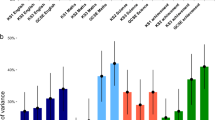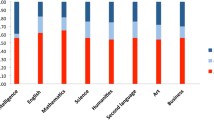Abstract
The relative effects of genetic and environmental factors in producing individual differences in educational achievement are compared across women and men and over birth cohorts. In a large sample of Australian twin pairs, the heritability of self-reported educational attainment did not vary among women and men born before and after 1950. In a “psychometric” model of twin resemblance, based on separate self-reports in 1981 and 1989, genetic factors explained 57% of the stable variance in educational achievement, while environmental factors shared by twins accounted for 24% of the variance. Corrections for phenotypic assortative mating for educational level, however, suggested that estimated common-environmental effects could be entirely explained by the correlation between additive genetic values for mates. Taking this into account, heritability of “true” educational attainment in Australia may be as high as 82% with the remaining variation being due to individual environments or experiences. Unlike previous studies in Scandinavian countries, results in Australia suggest that factors influencing educational success are comparable between women and men and for individuals born at different points during this century.
Similar content being viewed by others
References
Anderson, D. (1993). Education and the social order: The effect of the private sector. In Western, J. (Ed.)Class Structure in Australia (in press).
Castles, I. (1992a).Education and Training in Australia (Nov. 1992), Australian Bureau of Statistics.
Castles, I. (1992b).Labour Force Status and Educational Attainment, Australia (Feb. 1992), Australian Bureau of Statistics.
Cederlof, R., Friberg, L., Jonsson, E., and Kaij, L. (1961). Studies on similarity diagnosis in twins with the aid of mailed questionnaires.Acta Genet. Stat. Med. 11:338–362.
Eaves, L., Last, K. A., Young, P. A., and Martin, N. G. (1978). Model-fitting approaches to the analysis of human behavior.Heredity 41:249–320.
Heath, A. C., Berg, K., Eaves, L. J., Solaas, M. H., Corey, L. A., Sundet, J., Magnus, P., and Nancy, W. E. (1985). Educational policy and the heritability of educational attainment.Nature 314:734–736.
Jardine R., Martin, N. G., and Henderson, A. S. (1984). Genetic covariation between neuroticism and the symptoms of anxiety and depression.Genetic Epidemiology 1:89–107.
Joreskog, K. G., and Sorbom, D. (1989).LISREL 7 User's Reference Guide, Scientific Software.
Kasriel, J., and Eaves, L. J. (1976). A comparison of the accuracy of written questionnaires with blood-typing for diagnosing zygosity in twins.J. Biosoc. Sci. 8:263–266.
Magnus, P., Berg, K., and Nancy, W. E. (1983). Predicting zygosity in Norwegian twin pairs born 1915–1960.Ciin. Genet. 24:103–112.
Martin, N. G. (1978). Genetics of sexual and social attitudes in twins. InTwin Research: Psychology and Methodology, Alan R. Liss, New York, pp. 13–23.
Martin, N. G., and Jardine, R. (1986). Eysenck's contribution to behavior genetics. In Modgil, S., and Modgil, C. ((eds.),Hans Eysenck: Consensus and Controversy, Falmer Press, Sussex.
Martin, N. G., and Martin, P. G. (1975). The inheritance of scholastic abilities in a sample of twins. I. Ascertainment of the sample and diagnosis of zygosity.Ann. Hum. Genet. 39:213–218.
Martin, N. G., and Wilson, S. R. (1982). Bias in the estimation of heritability from truncated samples of twins.Behav. Genet. 12:467–472.
Martin, N. G., Kehren, U., Battistutta, D., and Mathews, J. D. (1991). Iatrogenic influences on the heritability of childhood tonsillectomy: Cohort differences in twin concordance,Acta Genet. Med. Gemellol. 40:165–172.
McArdle, J. J., and Goldsmith, H. (1990). Alternative common-factor models for multivariate biometric analyses.Behav. Genet. 20:569–608.
Miller, P., Mulvey, C., and Martin, N. G. (1995). What do twin studies reveal about the economic returns to educations? A comparison of Australian and U.S. findings.American Economic Review,85:586–599.
Neale, M. C., and Cardon, L. R. (1992).Methodology for Genetic Studies of Twins and Families, Kluwer Academic, Dordrecht.
Neale, M. C., and Eaves, L. J. (1993). Estimating and controlling for the effects of volunteer bias with pairs of relatives (unpublished manuscript).
Neale, M. C., Eaves, L. J., Kendler, K. S., and Hewitt, J. K. (1989). Bias in correlations from truncated samples of relatives.Behav. Genet. 19:163–169.
Nichols, R. C., and Bilbro, W. C. (1966). The diagnosis of twin zygosity.Acta Genet. Stat. Med. 16:265–275.
Ooki, S., Yamada, K., Asaka, A., and Hayakawa, K. (1990). Zygosity diagnosis of twins by questionnaire.Acta Genet. Med. Gemellol. (Roma) 39:109–115.
Plomin, R., DeFries, J. C., and Peberts, M. K. (1977). Assortative mating by unwed biological parents of adopted children.Science 196:449–450.
Reynolds, C. A., Baker, L. A., and Pedersen, N. L. (1996). Models of spouse similarity: Applications to fluid ability measured in twins and their spousesBehav. Genet. 26: 73–88.
Scarr-Salapatek, S. (1971). Race, social class, and IQ.Science 17A:1285–1295.
Tambs, K., Sundet, J. M., Magnus, P., and Berg, K. (1989). Genetic and environmental contributions to the covariance between occupational status, educational attainment, and IQ: A study of twins.Behav. Genet. 19:209–221.
Teasdale, T. W., and Owen, D. R. (1984). Heredity and familial environment in intelligence and educational level—a sibling study.Nature 309:620–622.
Vogler, G. P., and Fulker, D. W. (1983). Familial resemblance for educational attainment.Behav. Genet. 13:341–354.
Watkins, M. P., and Meredith, W. (1981). Spouse similarity in newlyweds with respect to specific cognitive abilities.Behav. Genet. 11:1–22.
Western, J. (1993). Personal communication.
Author information
Authors and Affiliations
Corresponding author
Rights and permissions
About this article
Cite this article
Baker, L.A., Treloar, S.A., Reynolds, C.A. et al. Genetics of educational attainment in Australian twins: Sex differences and secular changes. Behav Genet 26, 89–102 (1996). https://doi.org/10.1007/BF02359887
Received:
Accepted:
Issue Date:
DOI: https://doi.org/10.1007/BF02359887




